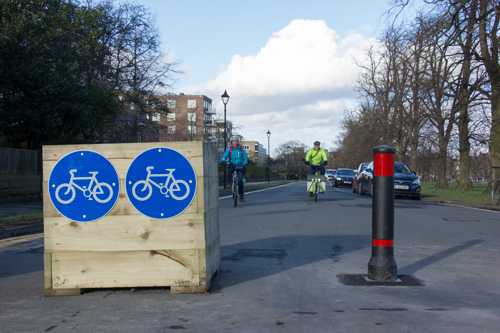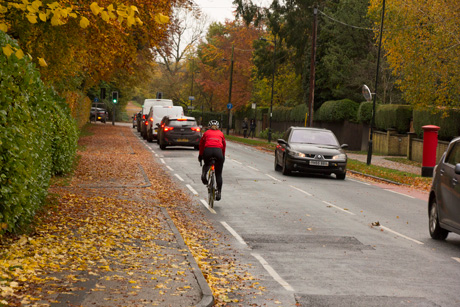
This is a brief summary of some ongoing projects.
5.1) Otley Road Cycleway
The Otley Road Cycleway project began when funding was secured from the DfT in November 2017. In August 2022, one small part of it (‘Phase 1’) has been built.
North Yorkshire Council (NYC) then abandoned ‘Phase 2’. This means that we have just an isolated segment of cycleway which is not useful because it does not form part of a joined-up route.
The project was very poorly managed.
5.1.1) Timetable
The first start date announced was March 2018. These are some of the dates when we were told work was going to start but it did not:
- August 2019
- October 2019
- March 2020
- April 2020
- July 2020
- August 2020
- December 2020
- January 2021
- July 2021
Work on Phase 1 finally started in September 2021.
Part of the delay was due to Stray land. At the time the bid was made, the then county council NYCC had not realised that the grass verges were Stray land, which complicated matters. This is publicly-available information, so it should not have come as a surprise. A consultation about a Stray land swap took place in August 2020.
Phase 1 is very much a small part of a route and not very useful on its own.
Phase 2 was going to follow on quickly, but then didn’t.
NYC held a (third) consultation in Autumn 2022. There was majority support for going ahead, but in February 2023 NYC decided to abandon Phase 2 of Otley Road Cycleway.
It looks very much as though the Autumn 2022 consultation was intended by NYC to provide an excuse to abandon the project.
5.1.2) Design Standards
There are constraints on Otley Road because there are mature trees that no one wants to lose. Nevertheless, Phase 1 does not represent the best possible design within those constraints.
This is our detailed critique of Phase 1. The main points are:
- there is one improvement over previous North Yorkshire pavement cycling efforts – priority over minor side roads
- at light-controlled junctions, the cycleway is not Direct – cyclists are sent a short way up side roads to a Toucan, where they wait in a small amount of space with pedestrians, while motor vehicles have the lion’s share of space and green time
- at the Harlow Moor Road junction, NYC cut down trees and removed verges – but in order to create extra lanes for motor vehicles. Cyclists and pedestrians are crammed into a ludicrously small space
5.2) Station Gateway

Harrogate Station Gateway is paid for by the Transforming Cities Fund, and originates with the West Yorkshire Combined Authorities. Initially, to an extent, WYCA upheld standards and kept the project on track.
The original designs reallocated space to active travel from motor vehicles, and the designs were broadly in line with LTN 1/20.
Unfortunately, Harrogate Station Gateway fell victim to endless consultations and delays, lack of backbone from the Executive, and an application for judicial review by opponents of the scheme.
As of January 2025, it has been turned into a scheme for motor vehicles – designed to get more cars along Station Parade faster.
NYC is the only English council to be misusing Transforming Cities Fund money in this way.
Work on site still has not started.
5.3) Beech Grove

Beech Grove is a link between Otley Road and the town centre and station.
A very good officer was instrumental in implementing a modal filter scheme on a experimental basis. He has since left NYC. In our experience, good officers who want to get things done leave, presumably because they are not supported.
The modal filter transformed Beech Grove as a cycle route and as a place for people. At busy times, over 100 people per hour used the planters as a safe crossing.
In August 2022, a decision on making the scheme permanent was due to be made at a BES Executive meeting. Then at the last minute NYC told us they were taking the modal filters out because the experiment had run its course. We are appalled at this decision.
This was done with no evidence report and no consultation or engagement, and was therefore a breach of the Network Management Duty to Support Active Travel (since withdrawn by Mr Sunak).
When consultation results were later published by NYC, they showed that there was 66% support to make the scheme permanent.
NYC told us that they were considering permanent measures for Beech Grove. Nearly 3 years after the modal filters were removed, nothing has come of that.
We don’t believe NYC’s promises of ‘jam tomorrow’ and have no confidence in their commitment to a replacement scheme or ability to deliver one.
5.4) ATF2: Victoria Avenue & A59 Knaresborough Road
NYC won funding from ATF2 for four cycling schemes in 2020 – three in Harrogate and one in Whitby.
Victoria Avenue is the last ATF 2 scheme standing after NYC abandoned the others.
5.4.1) Timetable
This has been the timetable of the ATF2 schemes up to August 2022:
- November 2020 – bid successful
- February 2021 – 1st consultation, on the locations of the schemes
- March 2021 – Oatlands Drive scheme dropped before the 2nd consultation; revenue funding to be used for Oatlands Feasibility Study instead
- March 2021 – 2nd consultation, on the details of the two remaining schemes
- Summer 2021 – Oatlands Feasibility Study scheduled to start but didn’t
- November 2021 – construction of Victoria Avenue & A59 scheduled to start but didn’t
- Feb/March 2022 – construction of Victoria Avenue & A59 scheduled to start but didn’t
- 31st March 2022 – DfT deadline for completion of construction (missed)
- 11th April 2022 – meeting between NYCC and HDCA to discuss latest Victoria Avenue & A59 designs
- 11th May, 27th May, 8th June, 27th June, 4th July, & 14th July 2022 – unanswered emails asking for progress
- August 2022 – still no progress or firm timetable
- April 2024 – cycling elements of Victoria Avenue scheme abandoned and replaced with 2 pedestrian crossings
- May 2024 – in the consultation, only 6 people supported NYC’s revised plans
- January 2025 – still no work started on site
We were pleased when North Yorkshire won ATF2 funding, but it has just been a tale of delay and incompetence. It looks as though there will be no improvements at all for cycling from this money, which is very disappointing to say the least.
5.5) Oatlands Drive

Safe cycle provision is needed on Oatlands Drive, because there are two schools there. Currently there are 95cm ‘murder-strip’ advisory cycle lanes that encourage dangerous close passes.
Officers came up with an excellent design for Oatlands Drive as part of the ATF 2 bid – making it one way and putting in cycle lanes either side with light segregation.
There was some vocal opposition to the Oatlands Drive scheme, and NYCC dropped the scheme without consulting on it. (They divided the consultation in two. The first one, on the location, took place; then the scheme was watered down to nothing before the second consultation).
The council spent its Oatlands ATF2 money on an Oatlands Constituency Feasibility Study. NYC finally published the report in December 2023. It is obvious that the council doesn’t intend to act on the report and build cycle infrastructure. The council is happy that it has got rid of money that it didn’t want, and the report will gather dust on a shelf.
The council still says it is going to build crossings of Oatlands Drive and Wetherby Road for Slingsby Walk. In 2024, the council effectively spent the whole year on two consultations, and the schemes were delayed again.
NYC has also put foward plans to make Oatlands Drive 20mph. We support this, but it will not make Oatlands Drive safe for cycling.
Five years after the council won money to build cycle infrastructure on Oatlands Drive we’re no closer to seeing it delivered.
5.6) Oatlands Bridleway

Oatlands Bridleway is a good example of a location where a relatively small improvement would make a big difference – but where NYC’s negative attitude and delays mean that nothing happens over months and years.
This is an important and well-used route past Oatlands Junior School. In accordance with the Core Design Principle that cycle routes should be Comfortable, there should be a sealed surface. This is specifically confirmed by para. 15.2.3 of LTN 1/20.

There is a strong desire from parents of children at Oatlands Junior and Infants Schools for better active travel facilities here.
We have raised the issue of the Oatlands Bridleway with NYC on countless occasions. Our requests were met with the usual broken promises and delays until August 2021, when contractors hired by NYCC tipped some gravel onto it. This was not an acceptable solution.
At some point since then and without telling us, NYC surfaced part of the bridleway with Flexipave. This is an improvement.
For more projects and requests, see our Priorities.
